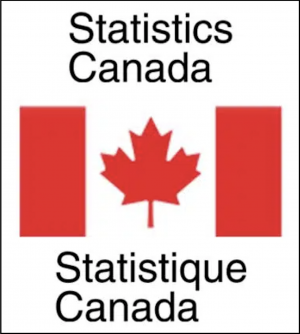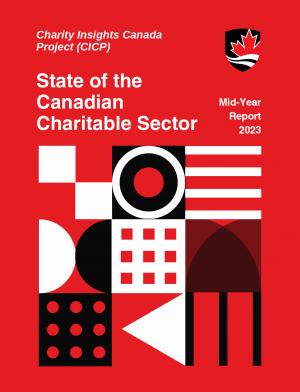On March 20, 2024, StatCan released data collected from 8,208 community, business and government nonprofit organizations, as well as from registered charities. Called “National Insights into Non-profit Organizations, Canadian Survey on Business Conditions, 2023,” the data includes the fact that, in 2023, 46.1% of organizations reported increased demand for services/products but only 24.3% reported that their overall capacity to meet demand had increased. Also, in 2023, 44.7% of organizations had one to 19 volunteers and 29.1% of organizations had 20 to 99 volunteers.
A direct link to the data tables is here. The Centre for Special Business Projects (CSBP), at Statistics Canada, released the data.

Sébastien Larochelle-Côté, Director of the Centre for Special Business Projects, at Statistics Canada.
The CSBP initiative is the first time StatCan has conducted a survey about the sector since 2003, when StatCan surveyed approximately 20,000 organizations. The data deficit about the charitable and nonprofit sector is a major concern in Canada, and many would like to see Statistics Canada better funded to collect more such data about the sector.
In January 2024, PANL Perspectives spoke to Sébastien Larochelle-Côté, the Director of the Centre for Special Business Projects, to find out what sort of data StatCan collects about the sector and the background for its recent survey of 8,208 nonprofit groups.
Sign up for MPNL’s free newsletter, PANL Perspectives.
Question: What does the CSBP do?

Statistics Canada building.
Larochelle-Côté: The Centre is involved in many projects that shed light on the issues and perspectives faced by businesses in Canada. The work of the division includes special surveys regarding businesses, with the nonprofit part being only one. Nonprofit organizations are special businesses, not just in the sense of profit-making; they operate differently and as a result may face different challenges.
Q: How and why did StatCan begin collecting data about the nonprofit sector recently?
Larochelle-Côté: It began with the Disaggregated Data Action Plan (DDAP) in 2021, when the Federal Budget provided $172 million to Statistics Canada for DDAP over five years. DDAP is whole-of-government approach, led by StatCan, to increase and improve statistics on diverse populations, and to support more representative data-collection methods.

StatCan makes data available online. For example, each quarter, there are “Non-profit” categories among data tables from the Canadian Survey on Business Conditions (CSBC).
Also, DDAP asked our Centre to create a survey to generate information about the business conditions of organizations — the obstacles, the perspectives, and other data.
We’re using this survey to create a module for data about nonprofits — to gather information about nonprofits. The quarterly Canadian Survey on Business Conditions (CSBC) is a good vehicle to do this module specifically about nonprofit organizations. The CSBC is surveying 30,000 businesses, and the DDAP module about nonprofits is surveying 8,000 nonprofits.
We don’t have a name for the DDAP module yet, and we don’t have a website about the module per se, but it’s part of the infrastructure of the CSBC. Also, the DDAP module will complement other surveys, such as the Survey on Giving, Volunteering and Participating (SGVP), which is conducted by Statistics Canada.
Q: A lot of resources are devoted to data about the business sector, relative to the nonprofit sector. Why is there such a discrepancy?
Larochelle-Côté: It’s a balancing act. The DDAP is precisely for the nonprofit sector — for segments of the population, such as the nonprofit sector, that aren’t traditionally looked at or weren’t prominent in our data sets.
Q: In 2003, the National Survey of Non-profit and Voluntary Organizations was a large, standalone survey. Is the DDAP module similar?

The Charity Insights Canada Project (CICP), an initiative at Carleton University, regularly generates new data and analysis about our sector, conducting surveys of approximately 1,000 registered charities each week. In early 2024, CICP released its “State of the Canadian Charitable Sector 2023 Mid-Year Report,” a summary of dozens of CICP’s original data reports from December 2022 to June 2023. The report is also available in French.
Larochelle-Côté: Statistics Canada ran the NSNVO as a standalone survey in 2003. We’re not going to do another standalone survey on nonprofits. A standalone survey would take a long time, and we want to produce timely data.
The DDAP module is something we can achieve quickly, in this fiscal year — and the data will be available at the end of this fiscal year, March 2024. We consulted with the sector and concluded this is the fastest way and the most cost effective way to ask 10 or 15 questions from a sample size of 8,000 nonprofit organizations.
When we release the data, in March 2024, we’ll provide a Daily — and possibly a paper. The goal will be to provide access to as many data tables as possible. The format of the tables will be similar to what we produce quarterly for the “Non-profit” parts of the Canadian Survey on Business Conditions.
Q: StatCan also runs the Satellite Account of Non-profit Institutions and Volunteering. What is that?
Larochelle-Côté: The Satellite Account of Non-profits isn’t a survey. Let me take a step back to explain. There are three types of data regarding nonprofits: (1) data about organizations; (2) data about individuals and households; and (3) data about the economic impacts of the sector.
First, the DDAP module (run by our Centre) will sample 8,000 nonprofit organizations and will provide information at an organizational level. It will have data about funding issues, for example, or about diversity of board members, or numbers of employees and volunteers — or about demands for services increasing, or demands declining? For example, “Do they have issues with fundraising? What groups do they primarily serve?” We’ll have questions like these — and the module will be the first source of information about organizations in the sector.

The “Canadian Knowledge Hub for Giving and Volunteering” was created by Volunteer Canada in partnership with Imagine Canada, Ajah, and others. The Hub contains data about giving and volunteering, including easily accessible data from StatCan’s “General Social Survey on Giving, Volunteering and Participating (GSS-GVP).”
The second type of data will be from sources that exist that ask questions from individuals, such as, “Do you get involved? Do you volunteer? Are you part of a nonprofit organization?” We do have that information as well, from an individual perspective, and an example is the General Social Survey on Giving, Volunteering and Participating (GSS-GVP).
The third type of data is the Satellite Account of Non-profit Institutions and Volunteering, which essentially provides information about the economic impact of the sector in this country. For example, “How many employees do organizations have? What is their share of GDP?” and that kind of information. The Satellite Account uses different sources of information from all over, so that we can build a picture of the economic contribution of the sector. The data is published on a quarterly basis.
Q: Is there an upcoming survey about “diversity”, similar to the Diversity of Charity and Non-profit Boards?
Larochelle-Côté: The Diversity of Charity and Non-profit Boards (DCNB) is an old survey, the results of which were released in 2021. However, the new DDAP module will have data about diversity — the diversity of board members, and the diversity of senior managers and employees.
Q: Would it be easier for everyone if more data were aggregated and open access, available to all Canadians?
Larochelle-Côté: Statistics Canada will always balance confidentiality requirements with access to data. We have The Statistics Act, and one of the things we, first and foremost, have to protect is the confidentiality of Canadians.
However, over the past couple of decades, and even in the past couple of years, we’ve come a long way in Canada. A lot of micro-data and aggregated data are available in Canada’s Research Data Centres (RDCs), which can be accessed by almost any university in the country — and those researchers commit to following the provisions of the Statistics Act. Access to data still means maintaining confidentiality.
Most data that we have about households is already on the RDCs. I know that academics have been asking for more access to more data for decades, but we also have to think about the public and confidentiality — and the trust that the public has in us.
Q: Are nonprofit groups involved in any of StatCan’s modules?
Larochelle-Côté: We’ve formed an external review committee regarding DDAP. It’s made up of Imagine Canada and about 30 other organizations that sit around the table to consult about the content of the module in the DDAP survey. We thank them for that. They’ve been extremely useful in helping us to disseminate the module. We began collecting data in January 2024.
Photo of Statistics Canada building is courtesy of Demetri1968 and Wiki Commons.
Sign up for MPNL’s free newsletter, PANL Perspectives.
Wednesday, March 20, 2024 in Data Discoveries, For homepage, News & Events
Share: Twitter, Facebook



